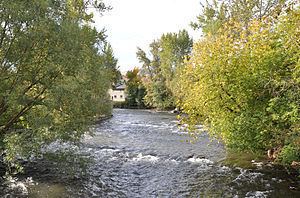- elevation 4,499 ft (1,371 m) - average 610 cu ft/s (17 m/s) Length 89 km Basin area 2,460 km² | - elevation 2,316 ft (706 m) Discharge 17.27 m³/s Basin area 2,460 km² | |
 | ||
- max 4,640 cu ft/s (131 m/s) | ||
Wallowa river fly fishing
The Wallowa River is a tributary of the Grande Ronde River, approximately 55 miles (89 km) long, in northeastern Oregon in the United States. It drains a valley on the Columbia Plateau in the northeast corner of the state north of Wallowa Mountains.
Contents
Map of Wallowa River, Oregon, USA
The river begins at the confluence of its east and west forks, which rise in southern Wallowa County, in the Eagle Cap Wilderness of the Wallowa–Whitman National Forest. It flows generally northwest through the Wallowa Valley, past the communities of Joseph, Enterprise, and Wallowa. It receives the Minam River from the left at the hamlet of Minam. Continuing north another 10 miles (16 km), it joins the Grande Ronde along the Wallowa–Union county line about 10 miles (16 km) north-northeast of Elgin and about 81 miles (130 km) from the larger river's confluence with the Snake River.
The Wallowa Valley was home to Chief Joseph's band of the Nez Perce Tribe. Chief Joseph asked the first white settlers to leave when they arrived in 1871. The U.S. government expelled the tribe and seized their property and livestock in 1877, when non-Indian farmers and ranchers wanted to settle the fertile Wallowa valley. The tribe was barred from returning to their homeland by the government after repeated petitions. The tribal members were shipped in unheated box cars to Indian Territory (now Oklahoma) to be placed in a prisoner of war camp never to see their home again.
FishEdit
The Wallowa River supports populations of steelhead, spring Chinook salmon, and mountain whitefish among other species. Sockeye salmon were extirpated from the Wallowa River when a small dam was constructed at the outlet of Wallowa Lake in the headwaters of the river. The dam was constructed to raise the level of the lake to store water for irrigation.
